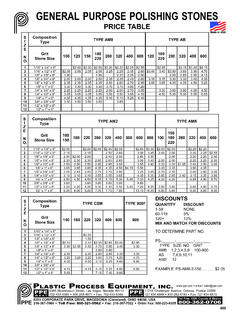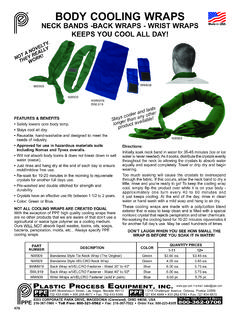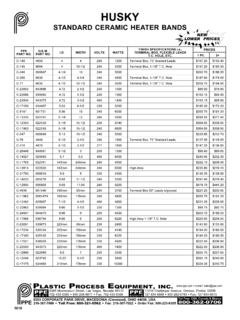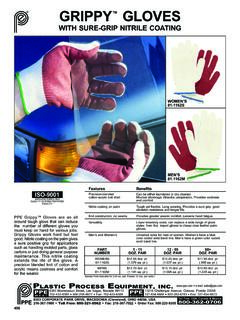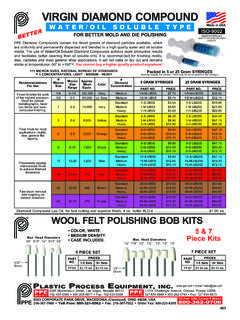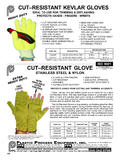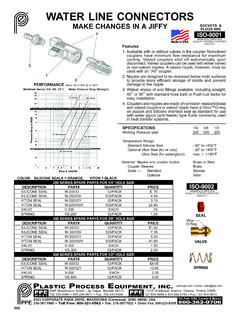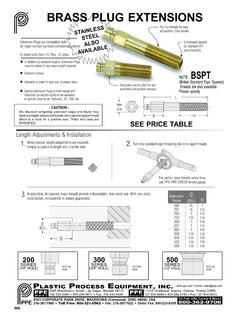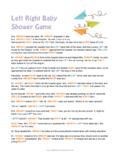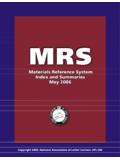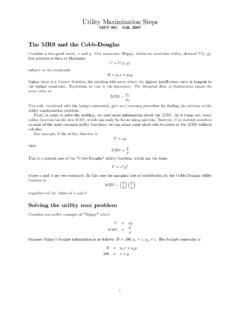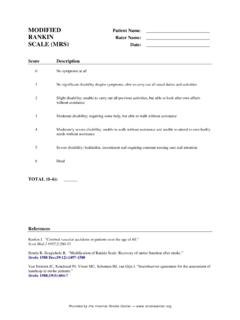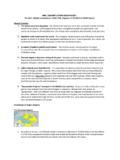Transcription of PERCHLOROETHYLENE, ALL GRADES
1 SAFETY DATA SHEETM47014 - ANSI - EN_____PERCHLOROETHYLENE, ALL GRADES_____1. CHEMICAL PRODUCT AND COMPANY IDENTIFICATION_____Company Identification:Occidental Chemical Corporation5005 LBJ Box 809050 Dallas, TX 75380-90501-800-752-515124 Hour Emergency TelephoneNumber:1-800-733-3665 or 1-972-404-3228 (USA); CHEMTREC (within USA andCanada): 1-800-424-9300; CHEMTREC (outside USA and Canada): +1703-527-3887; CHEMTREC Contract No: CCN16186To Request an or 1-972-404-3245 Customer Service:1-800-752-5151 or 1-972-404-3700 Product Identifier:PERCHLOROETHYLENE, ALL GRADEST rade Name:PERCHLOROETHYLENE, TECHNICAL; PERCHLOROETHYLENE, FLUOROCARBON (PTAP); PERCHLOROETHYLENE, INDUSTRIAL;PERCHLOROETHYLENE, VAPOR DEGREASING; PERCHLOROETHYLENE, ISOMERIZATIONS ynonyms:1,1,2,2 TETRACHLOROETHENE, TETRACHLOROETHENE,TETRACHLOROETHYLENE, PERCHLOROETHYLENE, PERCHLOROETHENEP roduct Use:Petroleum industry, Refrigerant manufacturing, Metal cleaning, Paint stripping,Aerosol carrierUses Advised Against:NOT FOR USE IN DRY date: 20-Feb-2015 SDS No.
2 : M47014 1 of 17 SDS Revision Date: 20-Feb-2015M47014 - ANSI - ENPERCHLOROETHYLENE, ALL GRADES_____2. HAZARDS IDENTIFICATION_____OSHA REGULATORY STATUS:This material is considered hazardous by the OSHA Hazard CommunicationStandard (29 CFR ).**EMERGENCY OVERVIEW:Color:ColorlessPhysical stateVolatile liquidAppearance:Clear liquidOdor:Mildly sweet odor, Chloroform-like odorSignal Word:DANGER MAJOR HEALTH HAZARDS: HARMFUL IF INHALED. MAY CAUSE DROWSINESS OR DIZZINESS. MAY BEHARMFUL IF SWALLOWED. MAY BE HARMFUL IF SWALLOWED AND ENTERS AIRWAYS. MAY BE HARMFULIN CONTACT WITH SKIN. CAUSES SKIN IRRITATION. CAUSES EYE IRRITATION. CAUSES DAMAGE TOCENTRAL NERVOUS SYSTEM (CNS), LIVER, RESPIRATORY SYSTEM. MAY CAUSE DAMAGE TO CENTRALNERVOUS SYSTEM (CNS), LIVER, KIDNEY, RESPIRATORY SYSTEM THROUGH PROLONGED OR REPEATEDEXPOSURE.
3 MAY CAUSE TOXICITY: TOXIC TO AQUATIC LIFE WITH LASTING STATEMENTS: Obtain special instructions before use. Do not handle until all safety precautionshave been read and understood. Do not breathe mist, vapors, or spray. Use with adequate ventilation and wearrespiratory protection when exposure to dust, mist, or spray is possible. Use only outdoors or in a well-ventilated contact with eyes, skin and clothing. Wear protective gloves, protective clothing, eye, and face protection. Washthoroughly after handling. Do not eat, drink or smoke when using this product. Avoid release to the environment.**_____GHS CLASSIFICATION:GHS: CONTACT HAZARD - SKIN:Category 2 - Causes skin : CONTACT HAZARD - EYE:Category 2B - Causes eye irritationGHS: ACUTE TOXICITY -INHALATION:Category 4 - Harmful if inhaledGHS: ASPIRATION HAZARD:Category 2 - May be harmful if swallowed and enters airwaysGHS: TARGET ORGANTOXICITY (SINGLE EXPOSURE):Category 1 - Causes damage to Central Nervous System (CNS), Liver,Respiratory SystemGHS: TARGET ORGANTOXICITY (SINGLE EXPOSURE):Category 3 - May cause drowsiness or dizzinessGHS: TARGET ORGANTOXICITY (REPEATEDEXPOSURE):Category 2 - May cause damage to Liver, Kidney, Central Nervous System(CNS), Respiratory System through prolonged or repeated exposure_____Print date: 20-Feb-2015 SDS Revision Date: 20-Feb-2015 2 of 17 SDS No.
4 : M47014M47014 - ANSI - ENPERCHLOROETHYLENE, ALL GRADES_____GHS: CARCINOGENICITY:Category 1B - May cause : HAZARDOUS TO AQUATICENVIRONMENT - ACUTEHAZARD:Category 2 - Toxic to aquatic lifeGHS: HAZARDOUS TO AQUATICENVIRONMENT - CHRONICHAZARD:Category 2 - Toxic to aquatic life with long lasting effectsUNKNOWN ACUTE TOXICITY:Not applicable. This product was tested as a whole. This information only pertains to untested SYMBOL:Health hazard, Exclamation mark, Environmental hazardGHS SIGNAL WORD: DANGER GHS HAZARD STATEMENTS:GHS - Health Hazard Statement(s)May be harmful if swallowed and enters airwaysHarmful if inhaledMay cause drowsiness or dizzinessCauses eye irritationCauses skin irritationCauses damage to organs : (Central Nervous System (CNS), Liver, Respiratory System)May cause damage to organs through prolonged or repeated exposure.
5 (Central Nervous System (CNS), Liver,Kidney, Respiratory System)May cause cancerGHS - Environmental Hazard Statement(s)Toxic to aquatic lifeToxic to aquatic life with long lasting effectsGHS - Precautionary Statement(s) - PreventionObtain special instructions before useDo not handle until all safety precautions have been read and understoodDo not breathe mist, vapors, or sprayUse only outdoors or in a well-ventilated areaWear eye protection, face protection, protective glovesUse personal protective equipment as requiredWash thoroughly after handlingDo not eat, drink or smoke when using this productAvoid release to the environment_____SDS No.: M47014 SDS Revision Date: 20-Feb-2015 Print date: 20-Feb-2015 3 of 17M47014 - ANSI - ENPERCHLOROETHYLENE, ALL GRADES_____GHS - Precautionary Statement(s) - ResponseIF INHALED: Remove person to fresh air and keep comfortable for breathingCall a POISON CENTER or doctor/physician if you feel unwellIF IN EYES: Rinse cautiously with water for several minutes.
6 Remove contact lenses, if present and easy to rinsingIf eye irritation persists: Get medical advice/attentionIF ON SKIN: Wash with plenty of waterIf skin irritation occurs: Get medical advice/attentionTake off contaminated clothing and wash it before reuseIF exposed or concerned: Get medical advice/attentionGet medical advice/attention if you feel unwellSpecific treatment (see Section 4 of the safety data sheet and/or the First Aid information on the product label)Collect spillage. Hazardous to the aquatic environmentGHS - Precautionary Statement(s) - StorageStore in a well-ventilated place. Keep container tightly closedStore locked upGHS - Precautionary Statement(s) - DisposalDispose of contents and container in accordance with applicable local, regional, national, and/or internationalregulationsHazards Not Otherwise Classified (HNOC)None KnownSee Section 11: TOXICOLOGICAL INFORMATION_____3.
7 COMPOSITION/INFORMATION ON INGREDIENTS_____Synonyms: 1,1,2,2 TETRACHLOROETHENE, TETRACHLOROETHENE, TETRACHLOROETHYLENE,PERCHLOROETHYLENE, PERCHLOROETHENEC omponentPercent [%]CAS NumberTetrachloroethylene [Perc] - Tetrachloride< FIRST AID MEASURES_____INHALATION: If inhaled and adverse effects occur, remove victim to fresh air and keep at rest in a positioncomfortable for breathing. Call a POISON CENTER or doctor/physician. See Notes to Physician below and Section 11for more CONTACT: If on skin, wash with plenty of water. If skin irritation occurs: Get medical advice/ attention. Take offcontaminated clothing and wash before reuse. See Notes to Physician below and Section 11 for more date: 20-Feb-2015 4 of 17 SDS No.: M47014 SDS Revision Date: 20-Feb-2015M47014 - ANSI - ENPERCHLOROETHYLENE, ALL GRADES_____EYE CONTACT: Rinse cautiously with water for several minutes.
8 Remove contact lenses, if present and easy to rinsing. If eye irritation persists: Get medical : If swallowed, rinse mouth with water (only if the person is conscious). Never give anything by mouth toan unconscious or convulsive person. If feeling unwell, contact a poison center or Important Symptoms/Effects (Acute and Delayed) :.Acute Symptoms/Effects: Listed (Breathing): Respiratory System Effects: Central Nervous System (CNS) effects are characteristicfollowing inhalation of chlorinated hydrocarbons and can range from lightheadedness at low level exposures toloss of consciousness at high levels. CNS effects are an early warning that exposure to high levels has occurredand there is risk of cardiac effects (palpitations, low blood pressure, arrhythmia, arrest). CNS effects include thefollowing symptoms: abdominal pain, nausea, vomiting, headache, lightheadedness, blurry or double vision,personality changes, weakness, slurred speech, stupor, incoordination (disequilibrium, ataxia), coma, andrespiratory arrest.
9 May irritate upper : Skin Irritation. Skin exposure may cause irritation, rough red, dry skin, edema, : Eye Irritation. Eye exposure may cause irritation, tearing, pain, conjunctivitis, clouding of (Swallowing): Ingesting this material may cause gastrointestinal irritation, nausea. vomiting,headache, breathing difficulty, reduced blood pressure, weak and rapid pulse, Central Nervous System (CNS)depression, and Central Nervous System (CNS) symptoms such as sedation, headache, tremor, nystagmus andmemory problems. Ingestion may cause unconsciousness and Health Effects: Most people can smell perchloroethylene at levels of 5-50 ppm (OSHA PEL is 100 ppm).Odor is an adequate warning for high dose acute exposures, but might not be adequate for prolonged exposuredue to olfactory fatigue. Vapors are heavier than air, can collect in low lying areas and cause asphyxiation.
10 CNSeffects have been observed at exposures of 100 to 300 ppm. Exposures of 1000 to 1500 ppm for less than 2hours have caused symptoms of mood changes, slight ataxia, faintness and dizziness. Exposure to higherconcentrations for longer periods can lead to collapse, coma, or Symptoms/Effects:- Respiratory System Effects: May cause chemical or irritant induced asthma or bronchoconstriction. May cause achemical pneumonitis. Reduced renal output (oliguria), elevation of liver enzymes, to renal failure and liver failure- May cause effects to the skin such as chronic dermatitis, dermal hypersensitivity- May cause eye damage such as corneal damage, decreased vision- May cause delayed liver and kidney effects- Prolonged exposures may result in memory and concentration impairment, vision disturbances, dizziness,irritability, ataxia (difficulty walking), and peripheral neuropathyInteraction with Other Chemicals Which Enhance Toxicity: May potentiate other agents that cause CentralNervous System (CNS) depression and respiratory system depression.
